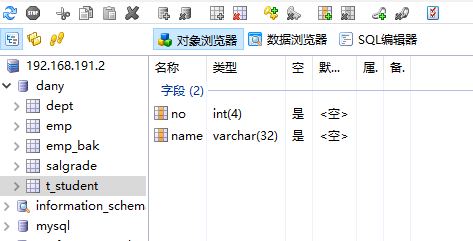MySQL
Using tools
- Command Line Windows
- MySQL Front

I. Common MySQL Data Types
1. char
- Occupied byte number char(n)
- Fixed length string, fixed size storage control
- For example: char(2)
2. varchar
- Occupied byte number varchar(n)
- Variable length string, storage space equal to actual data space
- A string containing only English characters
3. int
- Four bytes occupied
- integer
- For example, self-increasing ID and number of representations
4. bigint
- Occupy 8 bytes
- Long integer
- Large self-increasing ID
float (numeric), double (numeric), date (date and time, 8 bytes), BLOB (binary large object), CLOB (character large object)...
Classification of SQL Statements
1. DQL Statement - Data Query Language (select)
1.1 Simple Query
Query a single field
select field name from table name; Note: All symbols are in English.
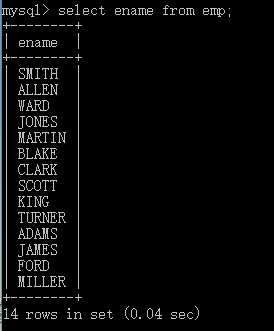
Query multiple fields
select field name, field name from table name;
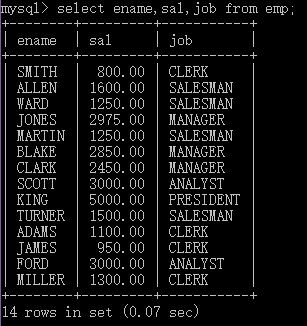
Query all fields
select * from table name;
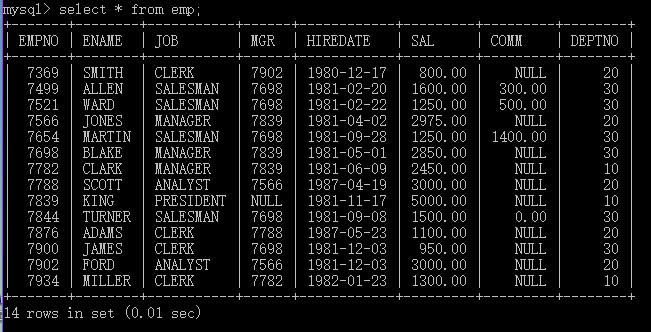
1.2 Exercises (Calculating the annual salary of each employee)
select ename,sal*12 from emp;
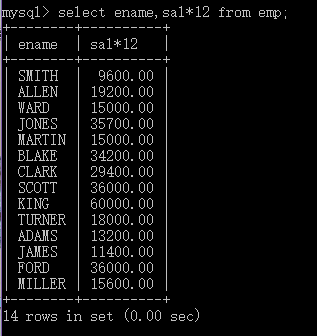
//Further modify the field name after the annual salary query select ename,sal*12 as yearsal from emp;
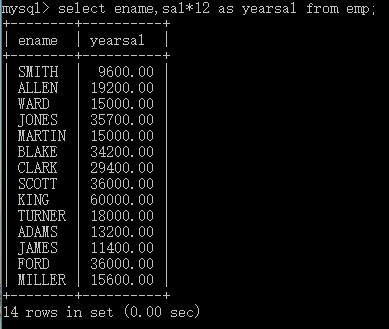
1.3 Conditional Query
Note: Conditional queries need to use where statements, where must be placed in the from statement table and surface;
Equal sign (=) operator
//Search for 5,000 employees with a monthly salary equal to select ename,sal from emp where sal = 5000;

// Search for Employees Working for MANAGER
select ename,job from emp where job = 'MANAGER';
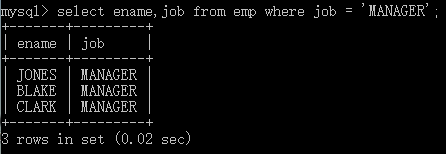
Unequal sign (<> or!=) operator
//Search for employees whose monthly salary is not equal to 5000 select ename,sal from emp where sal <> 5000; //perhaps select ename,sal from emp where sal != 5000;
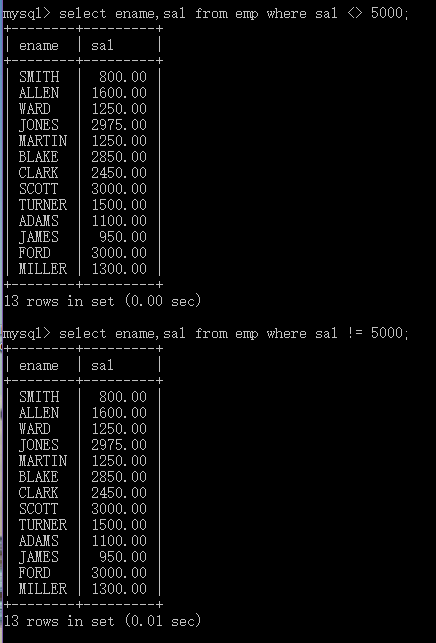
Note: <,<=,>>= Similar to the above
between…and…
select ename,sal from emp where sal between 1600 and 3000;
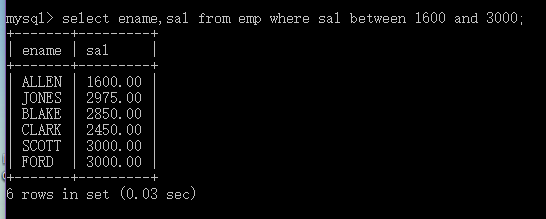
is null(is not null)
select ename,comm from emp where comm is null;
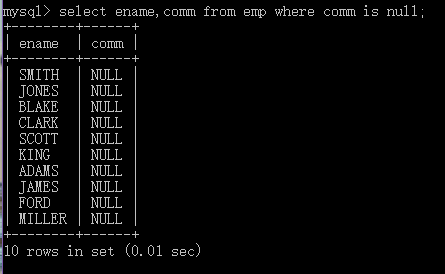
like (Fuzzy Query)
- % wildcard
- Placeholder

1.4 Exercises (Query employees with salaries greater than 1800 and department numbers 20 or 30)
select deptno,ename,sal from emp where sal > 1800 and (deptno = 20 or deptno = 30);

1.5 Data Sorting
Single field sort order by field name
//Sort by salary (default ascending order) select ename,sal from emp order by sal; //or select ename,sal from emp order by sal asc; //Descending order select ename,sal from emp order by sal desc; //Sorting of entry dates select ename,hiredate from emp order by hiredate desc;
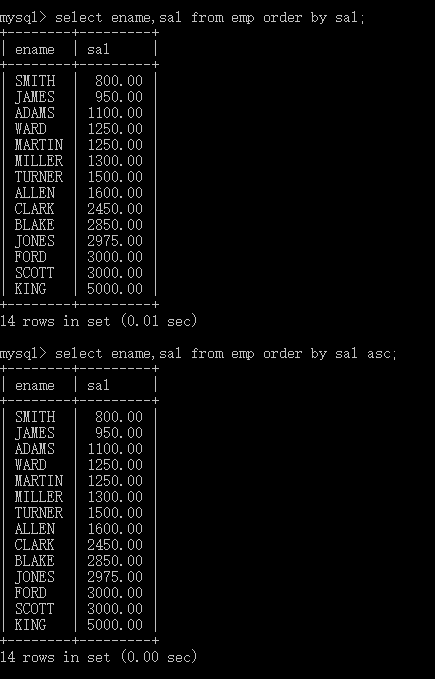
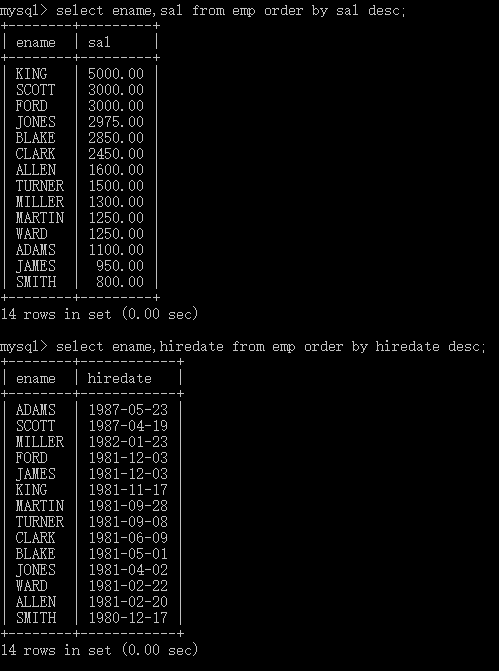
Multiple field sorting
//Sort by department number ascending and salary descending select deptno,ename,sal from emp order by deptno,sal desc;
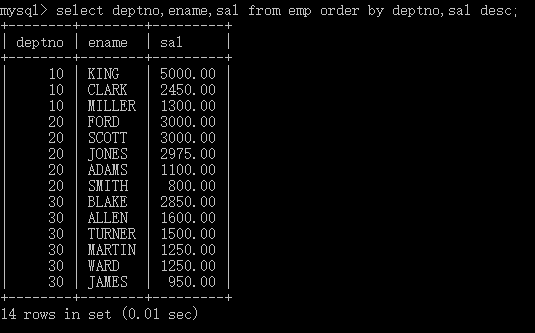
Sort by subscript (poor readability)
select * from emp order by 6 desc;
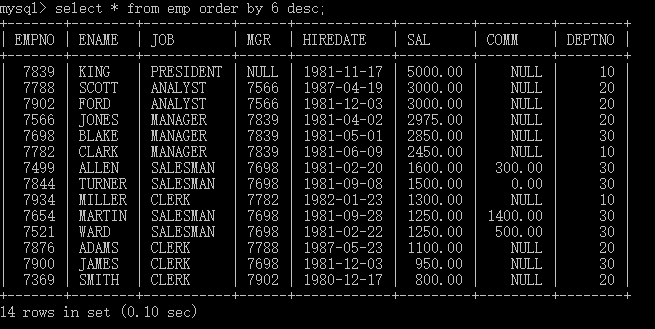
1.6 Data Processing Function
1) One-line processing function
//lower to lowercase select lower(ename) as lowername from emp;
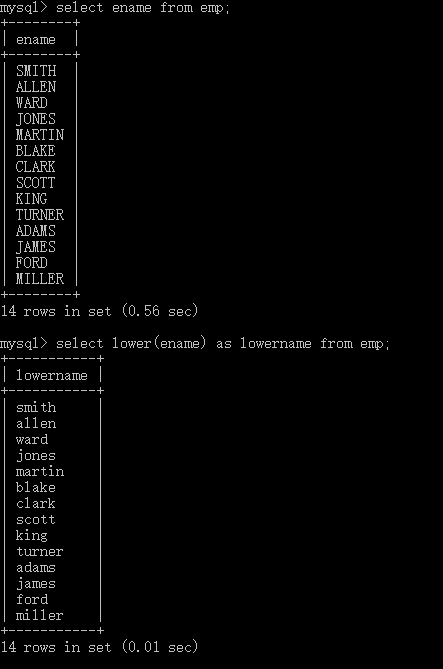
Note: The capitalization is similar
//Substr takes substr (the truncated string, starting subscript, truncated length) select substr(ename,1,1) as ename from emp;
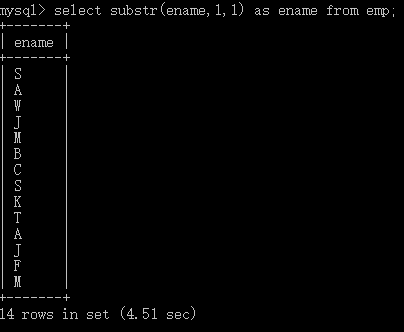
//lengh takes length select length(ename) as namelength from emp;

//trim removes spaces
select * from emp where ename = trim(' king ');

//round around select round(123.56); select round(123.56,1);
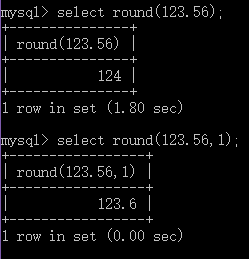
//rand() generates random numbers select rand(); select round(rand()*122);
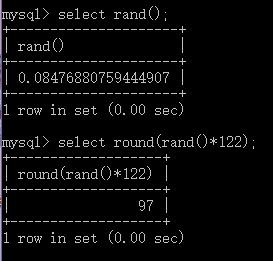
//case...when...then...else...end
//Usage: Match jobs, when it's MANAGER, salary will be increased by 10%, when it's SALESMAN, salary will be increased by 20%, salary of other jobs will remain unchanged.
select job,ename,
(case job
when 'MANAGER' then sal*1.1
when 'SALESMAN' then sal*1.2
else sal
end) as newsal from emp;

Note: None of the select statements can modify the original data of the data.
//ifnull null processing function select ename,(sal+comm)*12 from emp; select ename,(sal+ifnull(comm,0))*12 from emp;
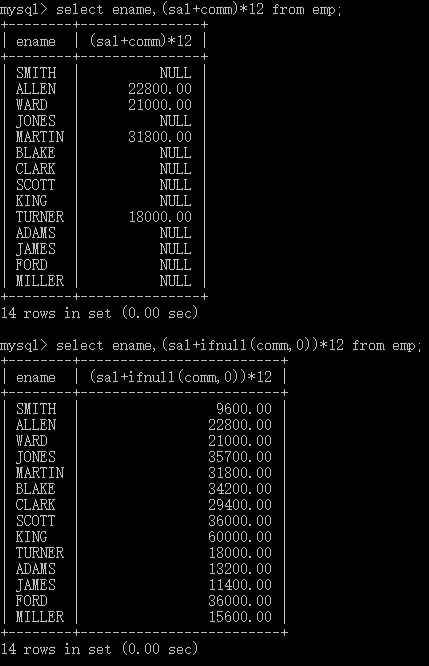
//str_to_date converts a string to a date
// Usage: str_to_date('date string','date format')
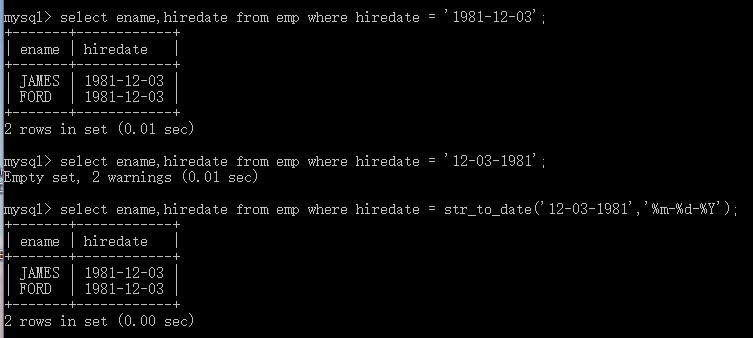
Date strings are commonly used to represent dates
//date_format Converts a date to a date string in a specific format // Usage: date_format (date type data,'date format')
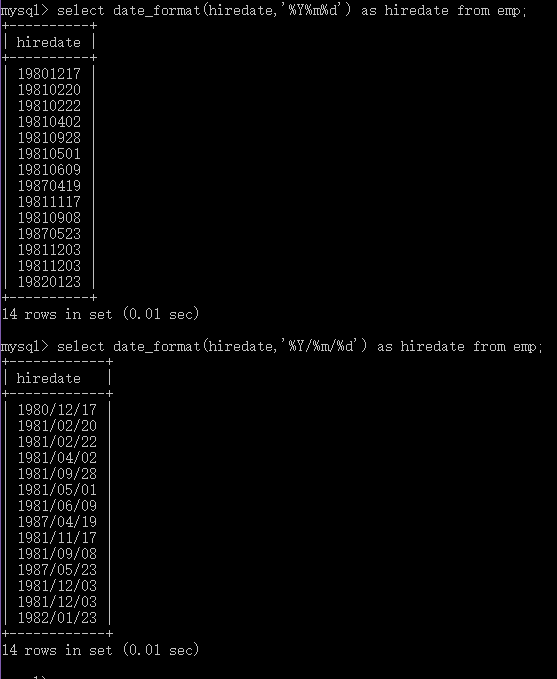
2) Multi-line processing functions (null values are automatically ignored)
//sum summation
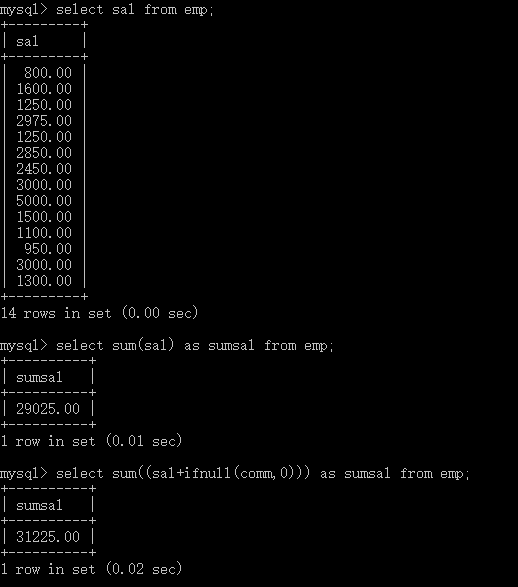
//avg average
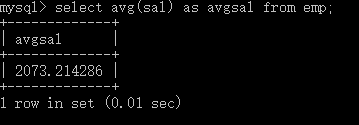
The max and min maximum and minimum are similar.
//count gets the number of records // Multi-line Processing Functions automatically ignore null values
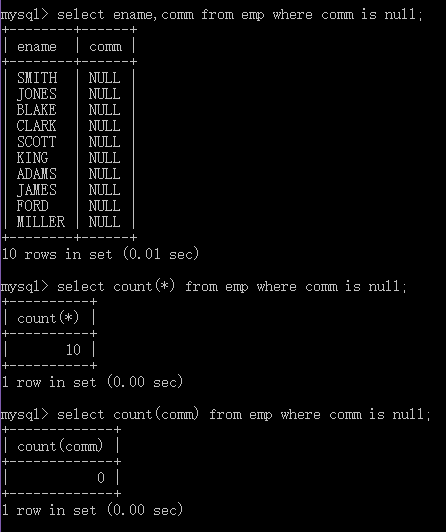
//distinct to remove duplicate records // Usage: distinct field name //or distinct field name 1, field name 2...

//Remove Department numbers and duplicate job records
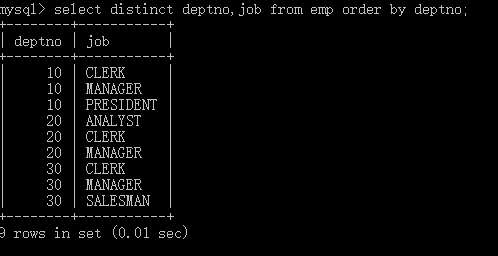
1.7 group by
//Queries by Working Group
select
job,max(sal) as maxsal
from
emp
group by
job;
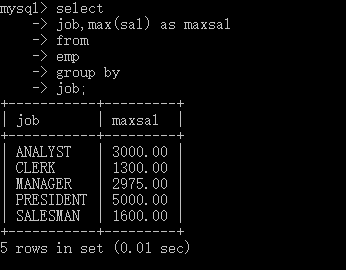
select
job,max(sal) as maxsal
from
emp
group by
job
order by
maxsal desc;
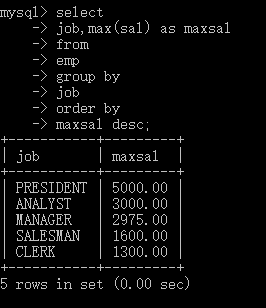
//Calculate the maximum salary for different positions in different departments
select
deptno,job,max(sal) as maxsal
from
emp
group by
deptno,job;
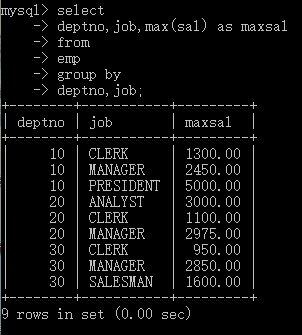
//Find out the maximum salary for each position, except MANAGER
select
job,max(sal) as maxsal
from
emp
where
job <> 'MANAGER'
group by
job;
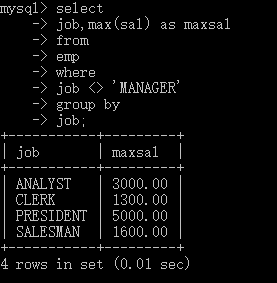
//Find out the average salary for each position and ask for an average salary of more than 2000.
//having is used after group by
//where used before group by
select
job,avg(sal) as avgsal
from
emp
group by
job
having
avgsal > 2000;
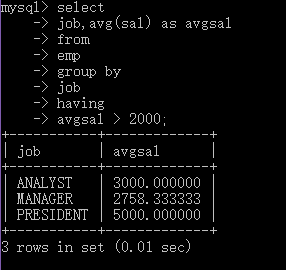
1.8 select statement summary
A complete SQL Statements are as follows:
select
xxx
from
xxx
where
xxx
group by
xxx
having
xxx
order by
xxx
- The order of the above keywords can not be changed, strictly abide by
- The execution order of the above statements;
- 1) from loads table files on hard disk into memory
- 2) where to extract eligible data. Generate a new temporary table
- 3) group by divides the current temporary table into several new temporary tables according to the data type in the column
- 4) having can filter out the non-conforming temporary tables generated by group by
- 5) select reads the current temporary table in columns
- 6) order by reorders the select ed temporary tables and generates new temporary tables
- 7) limit reads the final generated temporary data rows
1.9 Link Query (Cross-Table Query)
Chronological classification:
SQL92
select ename,dname from emp as e,dept as d where e.deptno = d.deptno;
SQL99
select
ename,dname
from
emp e
join
dept d
on
e.deptno = d.deptno
where
Data filtering conditions;
Classification of connection modes:
Inside Link: A key word is omitted:inner
Equivalent connection
For example: query the corresponding department name of employees
Non-Equijoin
For example, query the salary level corresponding to the salary of employees: show the name, salary, salary level of employees
Self link
For example: query the corresponding leadership name of employees, display the employee name and leadership name
1. Leadership Number of Employees
2. Query the leader's name and number
3. Table join condition: a.mgr = b.empno
External connection
Left Outer Connection/Left Connection
Right Outer Connection/Right Connection
Full connection
1.9.1 SQL92
select ename,dname from emp as e,dept as d where e.deptno = d.deptno;
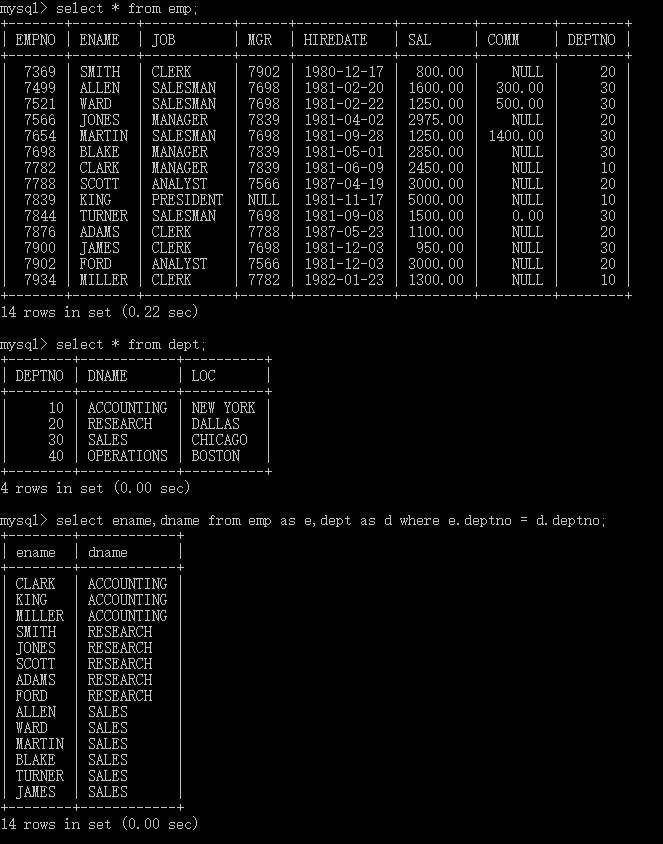
1.9.2 SQL99 (master this only)
select
ename,dname
from
emp e
join
dept d
on
e.deptno = d.deptno;
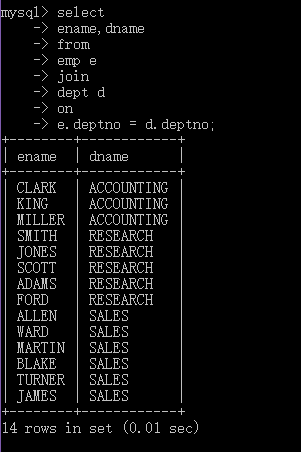
1.9.3 Non-Equivalent Connections
select
e.ename,e.sal,s.grade
from
emp e
join
salgrade s
on
e.sal between s.losal and s.hisal;
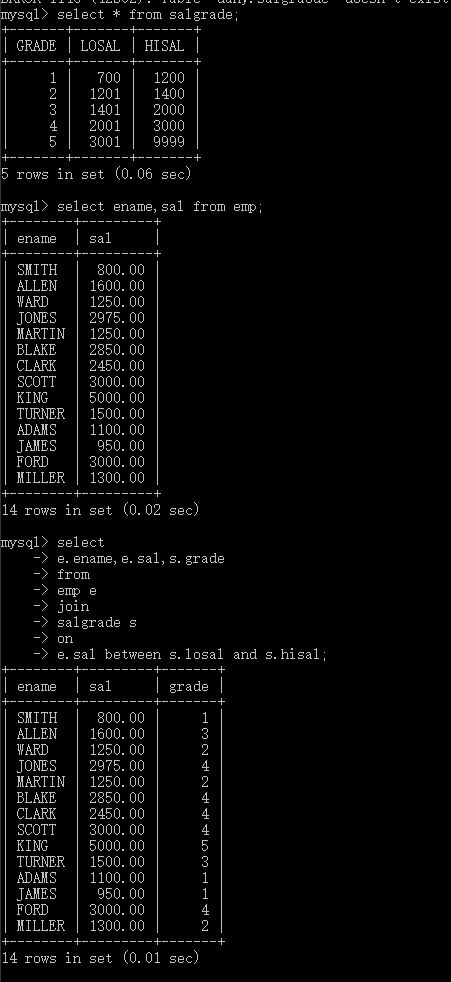
1.9.4 Self-Link
select
e.ename,b.ename
from
emp e
join
emp b
on
e.mgr = b.empno;
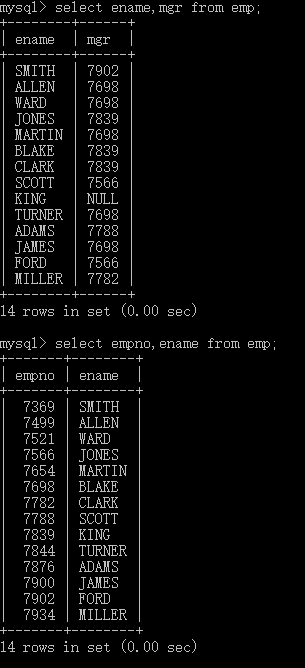
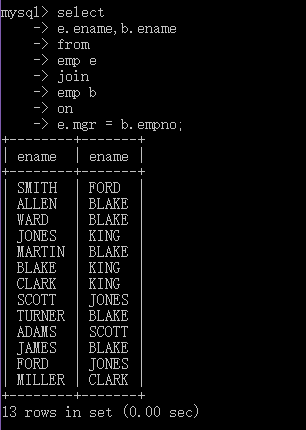
1.9.5 External Connection (omitting a keyword: outer)
Definition: A table and B table can complete matching records query out, one of the table records unconditionally complete query out, when the table does not match the records, will automatically simulate null value and sub-matching
- Left outer join: All rows in the left table and all matched rows in the right table
- Right outer join: All rows in the right table and all matched rows in the left table
Right outer join
select
e.ename,d.dname
from
emp e
right join
dept d
on
e.deptno = d.deptno;
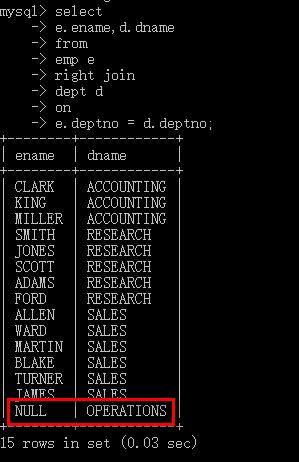
Practice
-
Find out the employee's Department name, employee's leadership name and salary level
emp,dept,salgrade
select
d.dname,
e.ename,
b.ename as leadername,
s.grade
from
emp e
join
dept d
on
e.deptno = d.deptno
join
emp b
on
e.mgr = b.empno
join
salgrade s
on
e.sal between s.losal and s.hisal;
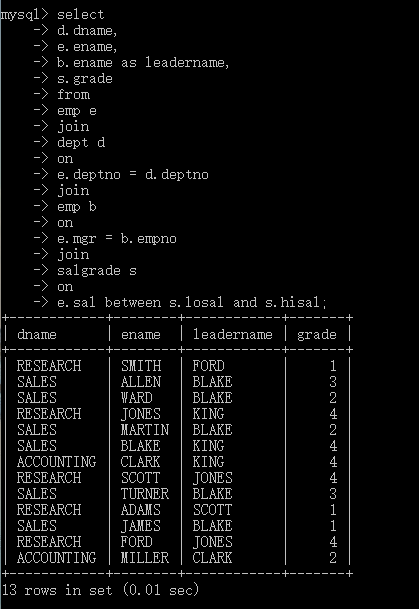
1.10 Subquery
1.10.1 After where
//Identify employees whose salaries are higher than the company's average, and ask for their names and salaries. select ename,sal from emp where sal > (select avg(sal) as avgsal from emp);

//Find out the average salary for each department, and ask to show the average salary and salary level.
//Step 1: Find out the average salary of each department first
select
e.deptno,avg(sal) as avrsal
from
emp e
group by
e.deptno;
//Step 2: Salary Level
//Connect
select
t.avgsal,s.grade
from
(select
e.deptno,avg(sal) as avgsal
from
emp e
group by
e.deptno) t
join
salgrade s
on
t.avgsal between s.losal and s.hisal;
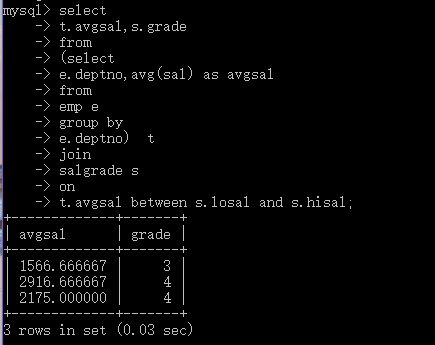
1.11 UNION Merge and Add Result Set
//Query out employees whose jobs are manager and salesman
select ename,job from emp where job = 'MANAGER' or job = 'SALESMAN';
select ename,job from emp where job in('MANAGER','SALESMAN');
select ename,job from emp where job = 'MANAGER'
union
select ename,job from emp where job = 'SALESMAN';
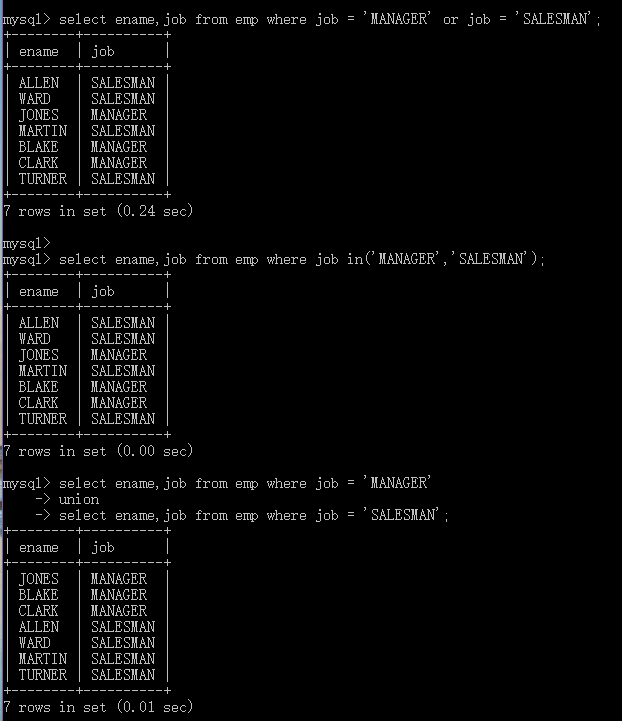
1.12 limit (used only in MySQL) to get the first or middle rows of data in a table
//Take the first five data select * from emp limit 0,5;
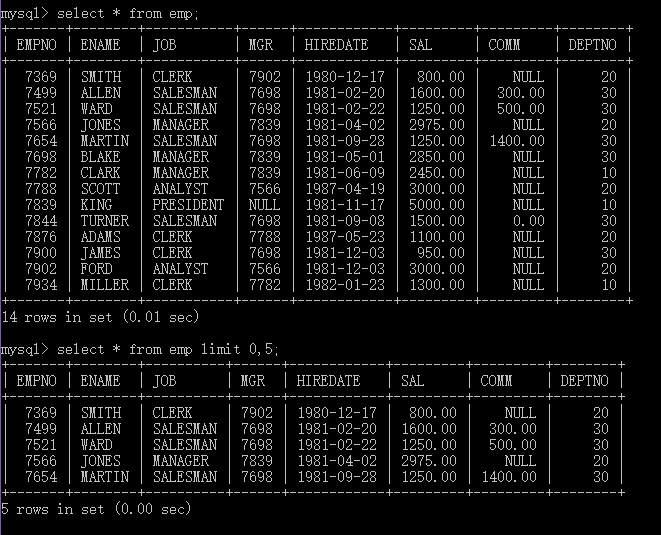
//Top five salary earners select ename,sal from emp order by sal desc limit 5; //Between Fifth and Eighth select ename,sal from emp order by sal desc limit 4,4;
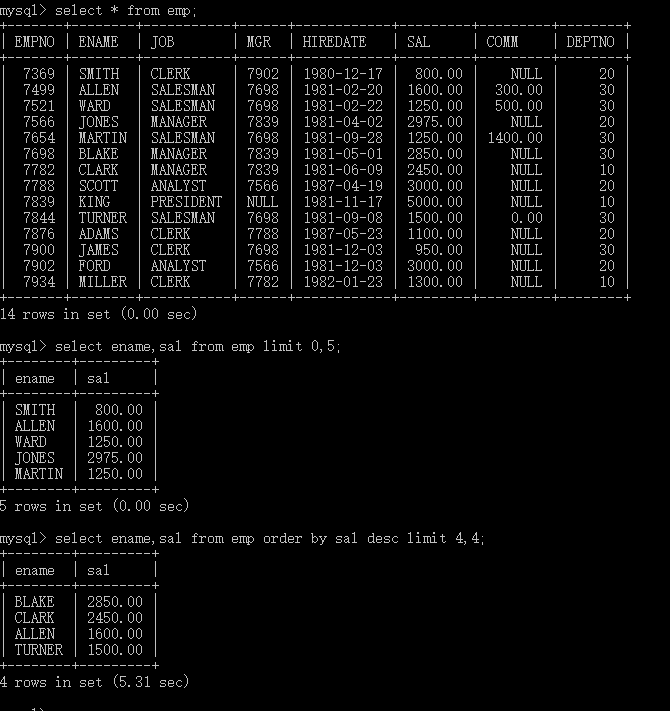
2. DML Statement - Data Operating Language (insert, delect, update)
2.1 insert (insert)
Syntax: insert into table name (field name, field name, field name) values (field value, field value, field value);
insert into t_student(no,name,gender,birth,email)
values
(1,'zhangsan','1',str_to_date('1944-01-02','%Y-%m-%d'),'zhangsan@163.com');
insert into t_student(no,name,gender,birth,email)
values
(2,'lisi','0','1949-08-11','lisi@163.com');
// mysql default date format year, month and day
insert into t_student(no,name,gender,birth,email)
values
(3,'wangwu','1',str_to_date('04-06-1956','%m-%d-%Y'),'wangwu@163.com');
insert into t_student(no,name,gender)
values
(4,'dany','1');
insert into t_student
values
(5,'jack','1','1977-05-3-23','jack@163.com');//Not recommended. If fields are not assigned, an error will be reported.
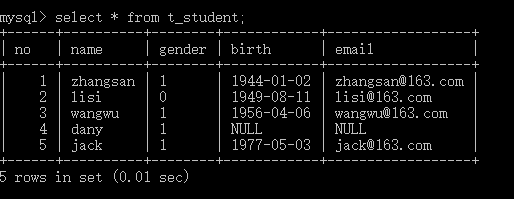
Supplement: When inserting multiple data quickly, the number of fields should be the same.
insert into emp_bak select * from emp where job = 'MANAGER';
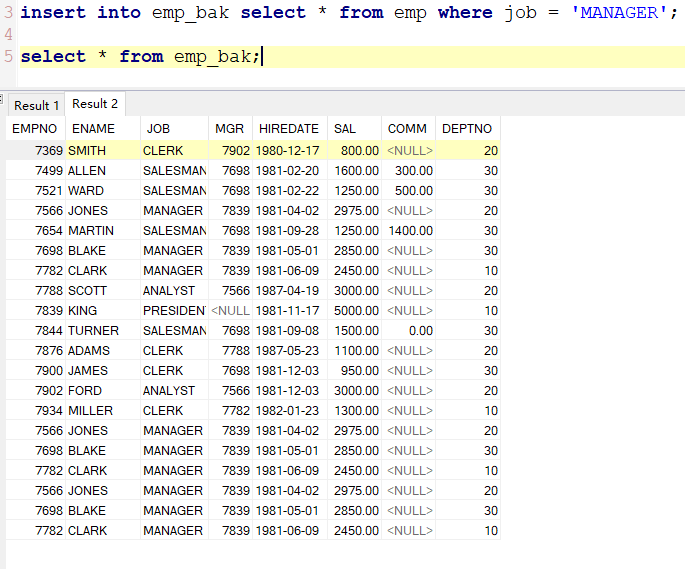
2.2 update (modification)
Syntax: update table name set field name = field value, field name = field value where restriction condition;
//Single field
update t_student set birth = str_to_date('1955-09-11','%Y-%m-%d') where no = 4;
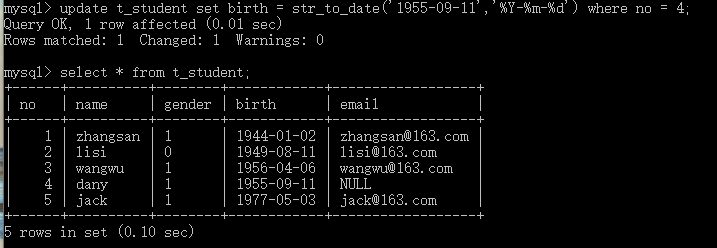
//Multiple fields update t_student set gender = 0, email = 'dany@163.com' where no = 4;
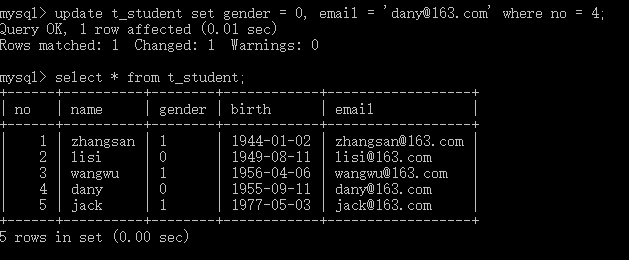
2.3 delete (delete)
Syntax: delete xxx from table name;
//delete from t_student; delete all records delete from t_student where no = 4;
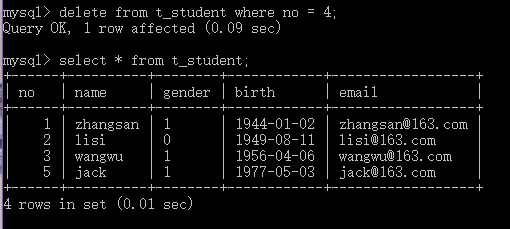
3. DDL Statement - Database Definition Language (create, drop, alter)
3.1 create tables
no INT(4)
Name: name varchar(32)
Gender: sex char(1)
Date of birth: birth date
Email: email varchar(128)
create table t_student(
no int(4),
name varchar(32),
gender char(1),
birth date,
email varchar(128)
);
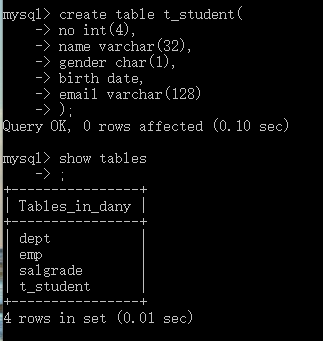
3.2 Delete the table (drop)
drop table t_student;//Deleting non-existent tables will cause errors drop table if exists t_student;//Delete non-existent tables without error
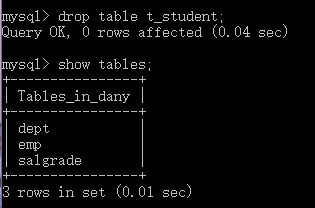
3.3 Quick replication of a table (the replicated table is a new table, not related to the original table)
create table emp_bak as select * from emp;
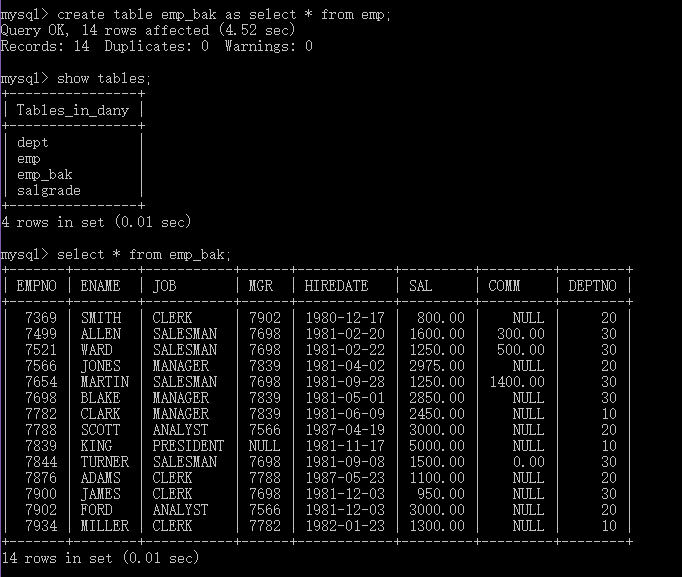
Supplement: default sets default values for fields
drop table if exists t_student;
create table t_student(
no int(4),
name varchar(32),
gender char(1) default '1',
birth date,
email varchar(128)
);
insert into t_student(no,name)
values
(4,'dany');
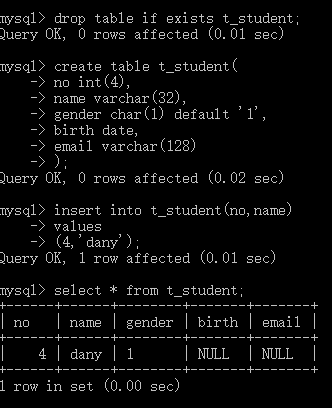
3.4 alter (modifying table structure)
drop table if exists t_student; create table t_student( no int(4), name varchar(32) ); //Add fields alter table t_student add email varchar(128); //Modify fields alter table t_student modify no int(8); //Delete field alter table t_student drop email; //Change the field name alter table t_student change name username varchar(32);
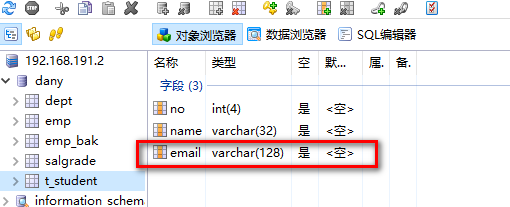
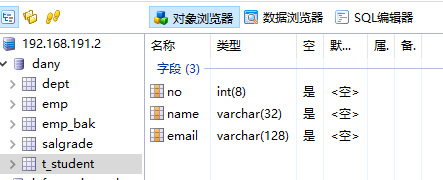
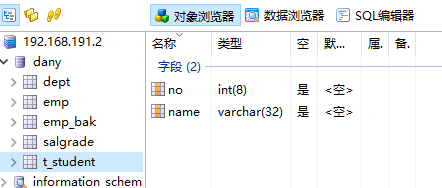
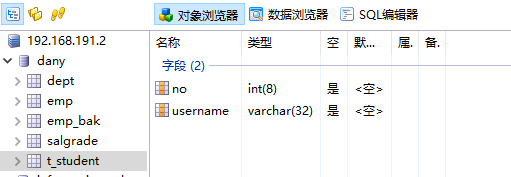
4. TCL Statement - Transaction Control Language (commit, rollback)
4.1 Transaction transaction
- commit: submit, end successfully, synchronize all DML statement operation records with data in the chassis hardware file
- Rollback: rollback, the end of the failure, clears all DML statement operation records.
- MySQL default automatic submission
//Turn off automatic submission //Mode 1: Start the transaction manually start transaction; ...DML Sentence commit; //Mode 2: Set the automatic provision to off set autocommit = off; ...DML Sentence commit;
4.2 Transaction isolation level
View isolation level select @@tx_isolation;
- isolation optional value:
- READ UNCOMMITTED
- READ COMMITTED
- REPEATABLE READ
- SERIALIZABLE
3. Create tables to add constraints
1. Non-null constraints
Function: Fields with no null constraints cannot be NULL values and must be assigned specific data
create table t_user( id int(4), name varchar(32) not null, email varchar(128) );
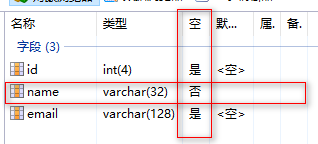
insert into t_user(id,email) values(1,'1123@126.com')
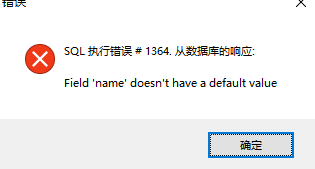
2. Uniqueness constraints
Role: Unique constrained fields are unique and non-repeatable
- For example: qq number, mobile phone number, etc.
drop table if exists t_user; create table t_user( id int(4), name varchar(32) not null, email varchar(128) unique ); insert into t_user(id,name,email) values(1,'zs','zs@162.com'); insert into t_user(id,name,email) values(1,'ls','zs@162.com');
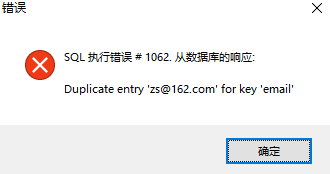
//Or written as drop table if exists t_user; create table t_user( id int(4), name varchar(32) not null, email varchar(128), unique(email) ); //Joint uniqueness drop table if exists t_user; create table t_user( id int(4), name varchar(32) not null, email varchar(128), unique(name,email) ); insert into t_user(id,name,email) values(1,'ls','zs@162.com'); insert into t_user(id,name,email) values(2,'ls','zs@162.com');
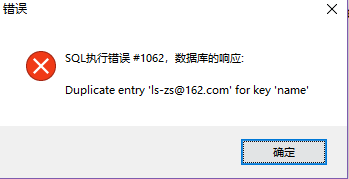
3. primary key constraint PK
Primary key constraints, primary key fields, primary key values
- Fields that add primary keys can neither be duplicated nor null
- After adding primary key constraints, the primary key not only has the function of "not null unique", but also automatically adds "index - index" to the primary key field.
drop table if exists t_user;
create table t_user(
id int(4) primary key,
name varchar(32) not null
);
insert into t_user(id,name) values(1,'lisi');
insert into t_user(id,name) values(2,'lisi');
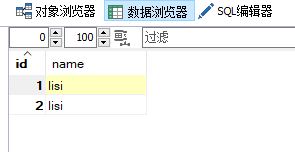
insert into t_user(id,name) values(1,'lisi');
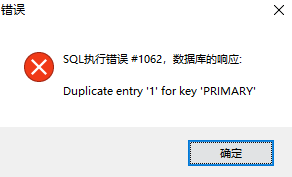
Automatically generating primary key values in MySQL (MySQL-specific)
drop table if exists t_user;
create table t_user(
id int(4) primary key auto_increment,
name varchar(32) not null
);
insert into t_user(name) values('zhangsan');
insert into t_user(name) values('lisi');
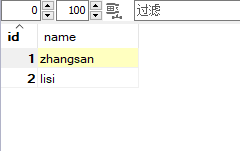
4. foreign key constraint FK
Foreign key constraints, foreign key fields, foreign key values
- Role: Solving data redundancy
- Foreign keys are divided into single foreign key and compound foreign key according to the number of foreign keys.
- [Single foreign key]: Adding foreign key constraints to a field
- [Composite foreign key]: Add a foreign key to multiple fields
4.1 example 1
Requirements: Designing database tables to store student information and class information
- t_student contains: sno,sname,classno,cname
drop table if exists t_student;
create table t_student(
id int(4) primary key auto_increment,
sno int(4),
sname varchar(32),
classno int(4),
cname varchar(32)
);
//Divide the above table into two tables
//Parent table
drop table if exists t_class;
create table t_class(
cno int(4) primary key,
cname varchar(32)
);
//Child table
drop table if exists t_student;
create table t_student(
sno int(4) primary key auto_increment,
sname varchar(32),
classno int(4),
constraint t_student_classno_fk foreign key(classno) references t_class(cno)
);
//Adding Foreign Key Constraints to Class Number
insert into t_class(cno,cname) values(100,'Class 1 in grade three');
insert into t_class(cno,cname) values(200,'Class 2 in grade three');
insert into t_class(cno,cname) values(300,'Class 3 in grade three');
insert into t_student(sname,classno) values('Zhang San',100);
insert into t_student(sname,classno) values('Li Si',100);
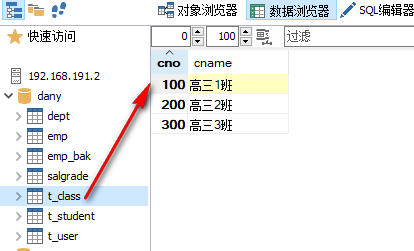
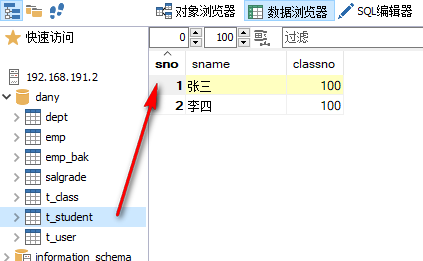
insert into t_student(sname,classno) values('Wang Wu',400);
//With foreign key constraints, errors will be reported

Be careful:
- Foreign key fields can be NULL, and data with empty foreign keys is also called orphan data.
- Referenced fields must have unique constraints
- With foreign key references, the tables are divided into parent and child tables, the above schedule is t_class, and the child table is t_student.
- When creating a table, the parent table is first created, and then the child table is created; when inserting data, the parent table data is first inserted, and then the child table data is inserted.
select
s.sname,c.cname
from
t_student s
join
t_class c
on
s.classno = c.cno;

5. Cascade updates and deletions (rarely used)
Usage: When adding cascade updates and deletions, you need to add keywords after foreign key constraints.
- Note: Cascade updates and deletions are carefully used because cascade operations change or delete data
5.1 Cascade Delete: on delete cascade
Definition: When deleting parent table data, cascade deletion of child table data
//Modify constraints alter table t_student drop foreign key t_student_classno_fk; alter table t_student add constraint t_student_classno_fk foreign key(classno) references t_class(cno) on delete cascade;
After the modification, if the class 1 of Senior Three in the parent table t_class table is deleted, the class 1 of Senior Three in the child table t_student will be deleted.
5.2 Cascade Updates: on update cascade
Update the parent table data, and the data associated with the child table will also be updated.
Fourth, Three Norms of Database Design
1. The first paradigm: primary keys and fields can no longer be divided
Definition: Primary keys are required, duplicate records cannot appear in the database, and atomicity of each field can no longer be divided.
- Conclusion:
- Every row must be unique, that is, every table must have a primary key, which is the basic requirement of our database design.
- Primary keys are usually represented by numeric or fixed-length strings
- Regarding the indivisibility of columns, specific analysis should be made according to specific circumstances.
2. Second paradigm: Non-primary key fields rely entirely on primary keys
Definition: The second paradigm is based on the first paradigm, which requires all non-primary key fields in the database to rely entirely on the primary key and not produce partial dependencies.
3. The Third Paradigm
Definition: Based on the second paradigm, non-primary key fields are not required to produce transitions dependent on primary key fields
- For example: Student Number (PK) - Student Name - Class Number - Class Name
- The class name of non-primary key field depends on the class number, the class number depends on the student name, and the student name depends on the primary key student number, forming the transfer dependence and the primary key field.
4. Summary of Three Paradigms (Several Classical Designs)
Example one-to-one: t_ husband and t_wife tables
//Wife list
create table t_wife(
wno int(4) primary key,
wname varchar(32)
);
//Husband list
create table t_husband(
hno int(4) primary key,
hname varchar(32),
wifeno int(4) unique,
foreign key(wifeno) references t_wife(wno)
);
One-to-many, many-to-many are involved above.
